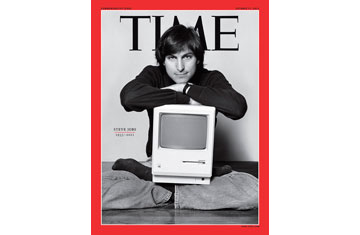
(2 of 2)
He intuitively understood the signals that a proper design sent. When he and his design sidekick Jony Ive built the first iMac in 1998, Ive decided it should have a handle nestled into the top. It was more playful and semiotic than it was functional. This was a desktop computer. Not many people were really going to carry it around. But it sent a signal that you didn't have to be afraid of the machine; you could touch it, and it would defer to you. The engineers objected that it would add to the cost, but Jobs ordered it to be done.
His quest for perfection led to his compulsion for Apple to have total end-to-end control of every product it made. Most hackers and hobbyists liked to customize, modify and jack various things into their computers. To Jobs, this was a threat to a seamless user experience. His original partner, Steve Wozniak--a hacker at heart--disagreed. He wanted to include eight slots on the Apple II for users to insert whatever small circuit boards and peripherals they might want. Jobs reluctantly assented. But a few years later, when he built the Macintosh, Jobs did it his own way. There were no extra slots or ports, and he even used special screws so hobbyists could not open it up and modify it.
Jobs' instinct for control meant that he got hives, or worse, when contemplating great Apple software running on another company's crappy hardware, and he likewise was allergic to the thought of unapproved apps or content polluting the perfection of an Apple device. This ability to integrate hardware, software and content into a single, Apple-designed system enabled him to impose simplicity. The astronomer Johannes Kepler declared that nature loves simplicity and unity. So did Steve Jobs.
This led Jobs to decree that the Macintosh operating system would not be available for any other company's hardware. Microsoft pursued the opposite strategy, allowing its Windows operating system to be promiscuously licensed. That did not produce the most elegant computers, but it did lead to Microsoft's dominating the operating-system market. After Apple's market share shrank to less than 5%, Microsoft's approach was declared the winner in the personal-computer realm.
In the longer run, however, there proved to be advantages to Jobs' approach. His insistence on end-to-end integration gave Apple, in the early 2000s, an advantage in developing a digital-hub strategy, which allowed you to link your desktop computer with a variety of portable devices and manage your digital content. The iPod, for example, was part of a closed and tightly integrated system. To use it, you had to use Apple's iTunes software and download content from its iTunes Store. The result was that the iPod, like the iPhone and iPad that followed, was an elegant delight, in contrast to the kludgy rival products that did not offer such a seamless end-to-end experience.
For Jobs, belief in an integrated approach was a matter of righteousness. "We do these things not because we are control freaks," he explained. "We do them because we want to make great products, because we care about the user and because we like to take responsibility for the entire experience rather than turn out the crap that other people make." He also believed he was doing people a service. "They're busy doing whatever they do best, and they want us to do what we do best. Their lives are crowded. They have other things to do than think about how to integrate their computers and devices."
In a world filled with junky devices, clunky software, inscrutable error messages and annoying interfaces, Jobs' insistence on a simple, integrated approach led to astonishing products marked by delightful user experiences. Using an Apple product could be as sublime as walking in one of the Zen gardens of Kyoto that Jobs loved, and neither experience was the result of worshipping at the altar of openness or letting a thousand flowers bloom. Sometimes it's nice to be in the hands of a control freak.
A few weeks ago, I visited Jobs for the last time in his Palo Alto, Calif., home. He had moved to a downstairs bedroom because he was too weak to go up and down stairs. He was curled up in some pain, but his mind was still sharp and his humor vibrant. We talked about his childhood, and he gave me some pictures of his father and family to use in my biography. As a writer, I was used to being detached, but I was hit by a wave of sadness as I tried to say goodbye. In order to mask my emotion, I asked the one question that was still puzzling me: Why had he been so eager, during close to 50 interviews and conversations over the course of two years, to open up so much for a book when he was usually so private? "I wanted my kids to know me," he said. "I wasn't always there for them, and I wanted them to know why and to understand what I did."
